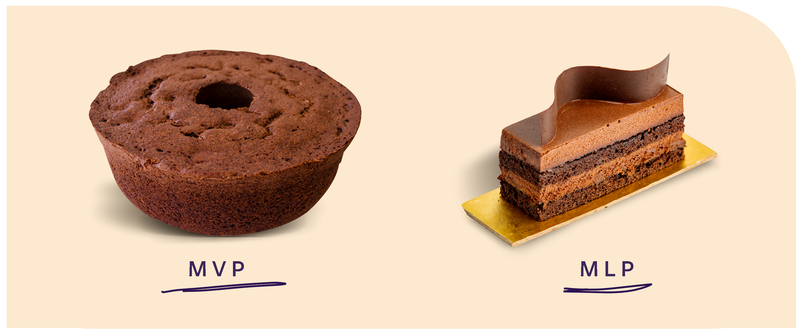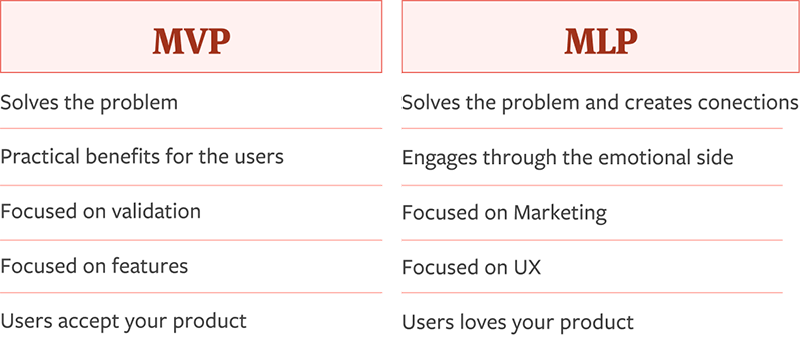MVP or MLP? Which one is better for your product?
One of these days I was talking with a friend about evolutions on the MVP concept, and I mentioned the word MLP. He asked me if Google was right and I was talking about poneys that looked like they just found a pot of gold at the end of the rainbow (look for “MLP” on google and understand 🔎 🕵).

All jokes aside, the idea that the concept of MVP could and should evolve makes a lot of sense for a company that knows that the success of its product doesn’t depende solely on its features, but also in its potential to delight the consumer. Before I get too deep in this, let’s take the first steps first.
So, what is MVP again?
The Minimum Viable Product, also known as MVP, is a word popularized by Eric Ries, in his book The Lean Startup. Ries used this concept as a way of creating products in a agile way, in cycles of build-measure-learn.
Before, products created the traditional way had long periods of conception, analysis and elaboration. The MVP, on the other hand, wants to create a minimal product, with only the necessary features, that can be analyzed faster in the validation process. In this context, the very first cycle, as Ries puts it, consists in the creation of the MVP: a product that has the minimal amount of effort, but that is still able to solve, in a simple way, the user’s pain and, further down the line, bring knowledge.
Minimal product created, time to refine it, right? Wrong! In the Lean methodology the idea is to validade, as fast as possible, the hypotheses created. This way, the wrongfully presumed ideas can be quickly discarded, and the first contact with the user can generate even more insights that can be translated in points of constant improvement.
The final user gives us data to validate the improvement of the product. The validation is essential for two reasons: 1. corrections and changes can be made at an early project stage, instead of only appearing later, when the product is more elaborated, thus reducing it’s risk and 2. The analysis’ complexity of the hypotheses is reduced. Paulo Caroli - The Lean Inception.
If the MVP is already consolidated, why even think of the MLP?
A Minimum Viable Product, by definition, should be feasible, valuable, usable and desirable, with a slice of each one of these characteristics.

Delivering an MVP doesn’t mean that the product is bad, simpleton or incompetent. Don’t mistake unfinished for bad, simple for simpleton and incomplete with incompetent. The MVP must be feasible (to be created), easily usable, generate value and be amazing (“wow”)! Paulo Caroli - The Lean Inception.
Even if the methodology used to arrive at the MVP is primarily focused on the users, often a few important features are put aside due to not being seen as priorities. In the real world, where companies depend of a lot of variables, frequently the features end up being chosen by a practical analysis, keeping in mind the incremental aspect the product should have, and not by an emotional analysis.
As you consider building your own minimum viable product, let this simple rule suffice: remove any feature, process, or effort that does not contribute directly to the learning you seek. Eric Ries, The Lean Startup: How Today's Entrepreneurs Use Continuous Innovation to Create Radically Successful Businesses.
At first glance, this approach makes a lot of sense, since decisions must be made in order to achieve the best result with the minimal cost (be it operational, financial or time-related). But nowadays, when most product ideas are improvements on other ones that already exist within the market and will probably face competition in whatever segment it operates, it is essential to conquer an audience from the first contact. It is in this scenario that the concept of the MLP becomes important (the Minimum Lovable Product). The concept, created by Brian de Haaff, on his book Lovability, describes products that aim to not only solve problems, but also to make consumeres fall in love.
You have to get out in the world and find out what constitutes value in the minds of your customers. The goal is no longer creating what people think is cool but creating what the customer cannot live without. Brian de Haaff. - Lovability: How to Build a Business That People Love and Be Happy Doing It.
The MLP takes a lot more time than the MVP, and it obviously has a higher cost, but the wager is on how different the experience can be for the user. After all, with a strategic mindset, we need people to love our products and not only to view it as a functional solution.
If the MVP is a chocolate cake indulges your hunger for sweets, imagine a chocolate pie slice with the size of your hunger, a pleasant presetation and a memorable experience. The pie is the MLP.

As a rule, if a product brings a new concept to the market, its more interesting to bet on the MVP, since is the fastest option to validate mistakes and hits on the process. It is also important to point out that the MVP already needs an in-depth UX Design process to understand what is, and what isn’t, negotiable for the user in that first stages. Despite that, we know that an entirely disruptive concept is not something we see every day. In this case, thinking in a solution that charms the customer at first sight is a smart strategy. And in this context we use the MLP.

In a really simplistic way, the MVP is born to be functional and evolve. The MLP, to be loved by the users at first sight. Succeeding is the goal in all situations, but there are decisions that will favor one choice at the expense of the other. The important thing is to understand in which moment your product is and with which approach will benefit it more.
Do you have an idea and need help in building your MVP or MLP? Check out our services and see how we can help you.
